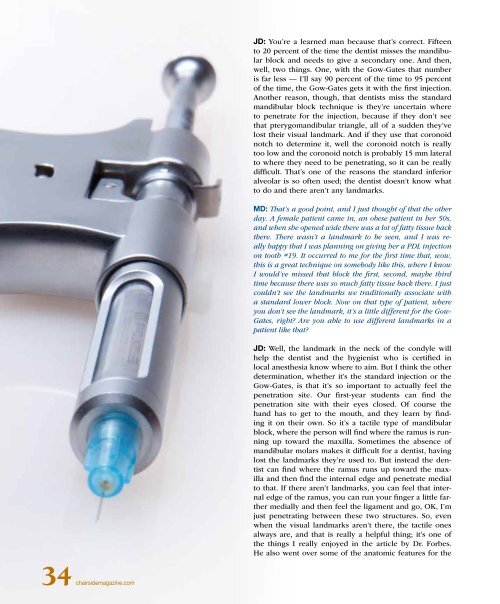PDF Version - Glidewell Dental Labs
PDF Version - Glidewell Dental Labs
PDF Version - Glidewell Dental Labs
You also want an ePaper? Increase the reach of your titles
YUMPU automatically turns print PDFs into web optimized ePapers that Google loves.
JD: You’re a learned man because that’s correct. Fifteen<br />
to 20 percent of the time the dentist misses the mandibular<br />
block and needs to give a secondary one. And then,<br />
well, two things. One, with the Gow-Gates that number<br />
is far less — I’ll say 90 percent of the time to 95 percent<br />
of the time, the Gow-Gates gets it with the first injection.<br />
Another reason, though, that dentists miss the standard<br />
mandibular block technique is they’re uncertain where<br />
to penetrate for the injection, because if they don’t see<br />
that pterygomandibular triangle, all of a sudden they’ve<br />
lost their visual landmark. And if they use that coronoid<br />
notch to determine it, well the coronoid notch is really<br />
too low and the coronoid notch is probably 15 mm lateral<br />
to where they need to be penetrating, so it can be really<br />
difficult. That’s one of the reasons the standard inferior<br />
alveolar is so often used; the dentist doesn’t know what<br />
to do and there aren’t any landmarks.<br />
MD: That’s a good point, and I just thought of that the other<br />
day. A female patient came in, an obese patient in her 50s,<br />
and when she opened wide there was a lot of fatty tissue back<br />
there. There wasn’t a landmark to be seen, and I was really<br />
happy that I was planning on giving her a PDL injection<br />
on tooth #19. It occurred to me for the first time that, wow,<br />
this is a great technique on somebody like this, where I know<br />
I would’ve missed that block the first, second, maybe third<br />
time because there was so much fatty tissue back there. I just<br />
couldn’t see the landmarks we traditionally associate with<br />
a standard lower block. Now on that type of patient, where<br />
you don’t see the landmark, it’s a little different for the Gow-<br />
Gates, right? Are you able to use different landmarks in a<br />
patient like that?<br />
JD: Well, the landmark in the neck of the condyle will<br />
help the dentist and the hygienist who is certified in<br />
local anesthesia know where to aim. But I think the other<br />
determination, whether it’s the standard injection or the<br />
Gow-Gates, is that it’s so important to actually feel the<br />
penetration site. Our first-year students can find the<br />
penetration site with their eyes closed. Of course the<br />
hand has to get to the mouth, and they learn by finding<br />
it on their own. So it’s a tactile type of mandibular<br />
block, where the person will find where the ramus is running<br />
up toward the maxilla. Sometimes the absence of<br />
mandibular molars makes it difficult for a dentist, having<br />
lost the landmarks they’re used to. But instead the dentist<br />
can find where the ramus runs up toward the maxilla<br />
and then find the internal edge and penetrate medial<br />
to that. If there aren’t landmarks, you can feel that internal<br />
edge of the ramus, you can run your finger a little farther<br />
medially and then feel the ligament and go, OK, I’m<br />
just penetrating between these two structures. So, even<br />
when the visual landmarks aren’t there, the tactile ones<br />
always are, and that is really a helpful thing; it’s one of<br />
the things I really enjoyed in the article by Dr. Forbes.<br />
He also went over some of the anatomic features for the<br />
34 chairsidemagazine.com

















